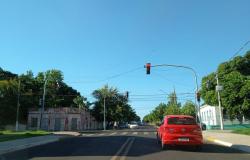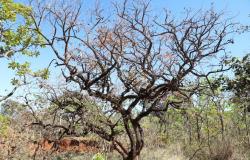The Rio Branco, Roraima’s main river, reached minus 39 centimeters this Monday (25) and is facing the second biggest drought in history. With the water level low, the scene is of rafts and canoes on the sand, fishermen adrift with no way to navigate and people crossing the river on foot.
This March’s mark is second only to the drought in 2016, when the Branco River reached minus 56 centimeters and faced the worst drought since monitoring began in 1972, 52 years ago, by the National Water and Basic Sanitation Agency (Agência Nacional de Águas e Saneamento Básico) ( ANA), operated by the Geological Survey of Brazil.
Roraima is facing a dry period, a climate situation that is expected to last until April. The state leads the number of hot spots in the country in 2024. With the lack of rain, rivers have dried up – as is the case of Rio Branco, and there are occurrences of forest fires that consume houses, animals and vegetation.
On the Branco River, sand dunes took over the landscape and the running water gave way to the extensive beach. At Orla Taumanã, one of the best-known tourist spots in Boa Vista, where it was possible to see the river running, it is now possible to walk underneath the structure.
Meanwhile, with four days to go until the end of March, it has not yet rained in Boa Vista and the tendency is for the river level to drop even further, which is worrying – the expected amount of rain for the period was 39.2 millimeters of rain, according to the National Institute of Meteorology (Inmet).
According to the geoscience researcher at the Geological Survey of Brazil, Jussara Cury, who monitors the basins of the Western Amazon, what is currently happening in the Branco River is a “moment of severe drought”.
“The levels have been considered low since October 2023 when the drought began where the lows normally occur in February of the following year, as well as rainfall in the region much below normal since January of the current year, the ebb was accentuated and in a certain way prolonged due to the lack of rain in March”, he explained.
Roraima has a large part of its territory located in the Northern Hemisphere, so it is currently in the dry season, called “Amazonian summer” — the period runs from October to March. The months of December and January are the driest, with little rainfall recorded.
A source of drinking water that supplies the homes of residents of Boa Vista, the Rio Branco has recorded a low volume of water since October. The president of the Roraima Water and Sewage Company (Caer), James Serrador, assesses that the situation in the capital is considered “sensitive” and suggests that the population save drinking water at home.
“Water is a scarce commodity and we are in a critical situation. Not long ago, less than two months, we were talking about the river with positive data and today we are negative. Therefore, we are very close to our safety margin” , said James, adding that:
“Today we are fully operational, but there may come a point where we have to turn off the intake pump because there will not be the necessary volume of water to guarantee supply.”
Those who live on the banks of the river lament the situation which, added to the clouds of smoke caused by forest fires in the sky of Boa Vista, worries the population.
‘I’ve never seen so much sand in the river’
Businessman and fisherman, Stanley Lira, 69 years old, lives on the banks of the Rio Branco, in Boa Vista. Known as “Boboco”, he manages the bar and restaurant “Marina Meu Caso”. For him, the drought the river is facing compares to that of 1998, when the state faced one of the worst droughts in history.
But, in his view, in 1998 there wasn’t as much sand as there is now. He believes that the new scenario is related to mining activity in rivers that are related to the Branco River, such as the Uraricoera, and to the dredgers that extract sand from the Branco River.
“There was a lot of siltation in the last four years. There was a lot of sand dredging, mining, soybean plantations. There was a drought, but before you could sail around by boat. Today there is no way. The movement of boats around here has greatly decreased. It’s something It’s scary. I’ve never seen so much sand in the river,” the fisherman told g1.
By way of comparison, Boboco showed where the level has already reached: covering the restaurant’s roof. Now, the river doesn’t even reach the ramp where the canoes are anchored. On the beach that formed in front of the site, canoes are stranded amid the sand and cloud of smoke.
However, Boboco believes in the power of nature to reconstitute, and is confident in the “turnaround” that the river will make when the rainy season begins, scheduled for April.
“I’m very sorry, because everyone who works with the river needs it. The population depends on this water. A lot of sand, but in two years, this area will be clean. The water will return with the rainy season,” he said.
In the assessment of Vladimir de Souza, PhD in Geosciences and professor at the Federal University of Roraima (UFRR), the current scenario in Roraima – with fires, drought and smoke – could impact the environment in the future.
“There is a loss of biodiversity due to the fires, and even forest areas are being affected. This all causes an environmental disaster”, he states.
For Vladimir de Souza, Stanley’s view of the reason for the drought is correct. The drought is caused by the strong warming of Atlantic waters, “added to deforestation and the drainage of lakes for agricultural activities, which harms the recharge of groundwater and rivers.”
“In other years, during El Niño, the rains were able to alleviate the effects of the drought. However, currently, due to the increase in deforestation and soil exposure, the drought is more severe”, explains the researcher.
‘It’s hard to go canoeing’
Fernando Silva Coelho, 44 years old, has lived in Roraima for 28 years. He has worked as a fisherman for 12 years and, since he started fishing professionally in the rivers of Roraima, he has never seen a drought as severe as this one during this period. From his life experience, according to him, it always rained during Holy Week.
“Today, it’s very different. Until now it hasn’t rained, because it was then that it was already raining here. During Holy Week it always rained. When the river dried up, it wasn’t so dry.”
Excited among the floating people on the sand, he said he was worried about the river that bathes the capital of Roraima.
“Very sad. Very sad indeed. We even get a little emotional seeing the river like this. Because we don’t want the river to stay like this. But it’s the climate change. It’s scary,” said the fisherman.
What surprises him most is the amount of sand in the middle of the river. “The beach is good, but for enjoying it. For people who fish, it’s not viable. We who depend on fishing.”
‘It’s just stone’
Someone who is also feeling the effects of the low levels of the Branco River is fisherman Jandeci Pinho, 47 years old. He works on a floating boat that, at the time of the interview, was stranded in the middle of the beach. He has been a fisherman for 10 years, he said, and has never seen the river reach this level.
“Never [vi o rio assim], this is the first time. It’s really bad, because we see everything dry, with nowhere to go by boat. We can barely navigate here, because everything is dry, it’s just rocks, it’s too shallow.”
He explains that he is not fishing due to piracema, a period in which the fish are reproducing, but that he continues sailing wherever he can.
“It’s dangerous to even put a canoe with a motor in such shallow water, sometimes we paddle or we go very slowly with the outboard motor, because with little water we can’t walk”, said the fisherman.
Another issue that has been hindering Jandeci is the clouds of smoke that have become constant in the capital. This hinders the vision of those navigating the river.
“The smoke is also very thick. We can’t see it, not even the bridge. And this smoke hinders those who work with canoes on the river, because sometimes it’s so thick that they can’t cross from one side of the river to the other. It also increases the risk of accidents”.
Clothesline in the middle of the river
Underneath the shore was the place that young Venezuelan migrant Jesus Lorono, aged 25, chose to wash and dry his clothes. He has been in Boa Vista for just under a month and, without work and nowhere to stay, he and his wife took advantage of the wind and sun to improvise a clothesline where the water of the Rio Branco used to flow.
In Spanish, he said he doesn’t know the river is full. Born in Puerto Ordaz, he came to Roraima fleeing the crisis experienced by Venezuela and in search of a better life.
“I’ve been sleeping, resting under the shore. There’s nowhere to wash [a roupa], this is the only place. And Boa Vista is very hot. Now I’m looking for a job. Back in Venezuela, I worked as a mechanic. It’s really very sad to see the river like this, but we’re making the most of it because we have nowhere to bathe or wash and dry our clothes,” Jesus told g1.
Smoke from forest fires
After two decrees officially recognizing the effects of the drought in Roraima, 14 of the state’s 15 municipalities are in an emergency situation.
The municipalities are: Amajari, Alto Alegre, Boa Vista, Cantá, Caracaraí, Caroebe, Iracema, Mucajaí, Pacaraima, Rorainópolis, Normandia, São João da Baliza, São Luiz and Uiramutã. Bonfim, in the North, is the only municipality that is not in a state of emergency.
But the lack of water is not the only problem faced by the population of Roraima. Amid the drought, forest fires consume houses, animals and vegetation, spreading smoke across the state.
To give you an idea, on a scale that goes from 0 to 160 µg/m3, a particulate material that can penetrate the lungs, reducing breathing capacity and even causing illnesses, the capital Boa Vista reached 334.5 µg/m3, at 6:36 pm this Sunday (24), according to Plataforma Selva.
The smoke comes from forest fires occurring in cities close to the capital and mainly in Guyana, a country that borders Roraima, and Suriname — although the state has many more fires than both countries.
Tags: Main river Roraima records #2nd biggest drought history
--




